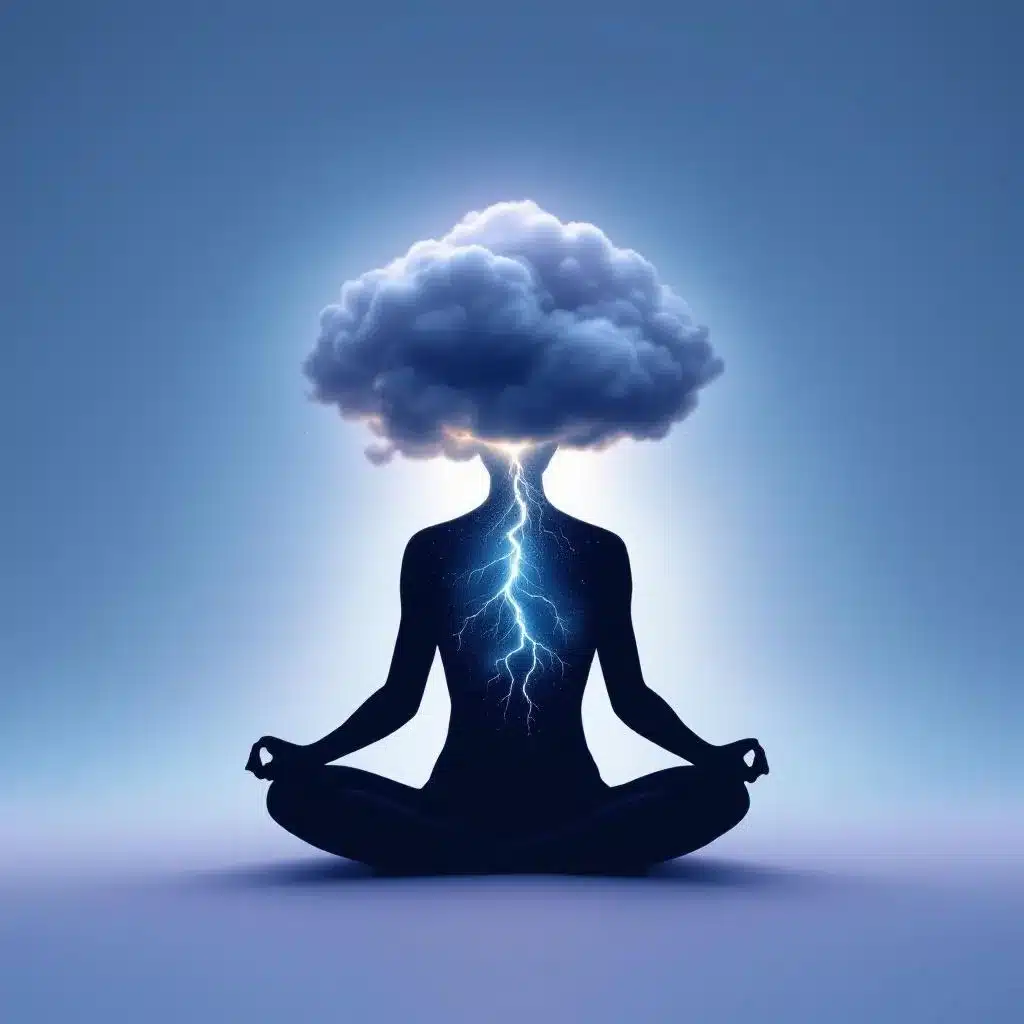When Anxiety Is Out of Control: A Guide to Regaining Your Calm

Your heart is pounding, a frantic drumbeat against your ribs. Your thoughts are a tangled mess, and it feels like the walls are closing in. This is it. That moment when anxiety isn’t just a worry—it’s a full-blown crisis, and rational thinking feels a million miles away. You feel utterly trapped in your own mind, desperate for an escape hatch from the panic.
But what if, even in that terrifying peak, there was a way to find an anchor? What if you could use the power of your own senses to carve out a tiny sliver of calm in the chaos? This is exactly what we’re going to walk through together. These aren’t just mindfulness techniques for daily stress; they’re specially designed for those moments you need them most. We’ll explore how to ground yourself when you feel like you’re spiraling, and yes, we’ll tackle that critical question: Can this stuff actually work when you’re in the throes of a panic attack?
Recognizing the Signs: When Does Anxiety Become Out of Control?
Let’s get one thing straight: anxiety is a normal part of being human. It’s that jolt of alertness before a big presentation or the butterflies you get on a first date. In those moments, anxiety is just a temporary visitor. But for so many of us, it can overstay its welcome, growing from a background hum into a deafening roar that takes over everything. Learning to manage an anxiety crisis starts with recognizing the warning signs before they hit a fever pitch.

Understanding when anxiety is out of control is really about learning to listen to your body and mind’s unique SOS signals. These red flags usually fall into three camps: physical, emotional, and cognitive. By getting to know your personal pattern, you can take action before you feel completely swept away.
Physical Warning Signs
When anxiety escalates, your body’s “fight or flight” system kicks into overdrive, even when there’s no real threat. This internal alarm can trigger some truly intense and frightening physical symptoms that convince you you’re in real danger.
- Racing Heart & Chest Pain: It feels like your heart is trying to beat its way out of your chest, doesn’t it? This often comes with a tightness or sharp pain in your chest, which can be terrifyingly mistaken for a heart attack.
- Breathlessness: You might feel like you just can’t get a full breath, leading to shallow, quick breathing or even a choking sensation. This is what often leads to dizziness and feeling lightheaded.
- Trembling and Dizziness: Uncontrollable shaking, trembling, or feeling wobbly on your feet can make even simple movements feel like a monumental task.
- Sweating and Chills: You might suddenly break out in a sweat or get waves of hot and cold flashes, even when the room temperature is perfectly fine.
- Nausea and Stomach Distress: Your gut is incredibly sensitive to stress. So when anxiety spikes, it can cause sudden nausea, stomach cramps, or that urgent, unpleasant dash to the bathroom.
Emotional Red Flags
As anxiety ramps up, your emotional state can feel like a rollercoaster you can’t get off of. These feelings are far more intense than your typical mood swings and can feel all-consuming.
- An Overwhelming Sense of Dread: This isn’t just regular worrying. It’s a deep, powerful feeling that something awful is about to happen, even if you have no idea what it is.
- Intense Irritability or Agitation: Ever find yourself snapping at people you love for no reason? Or feeling so restless you feel like you could crawl out of your skin? When patience vanishes and small annoyances feel like catastrophes, anxiety is likely the culprit.
- A Desperate Need to Escape: A classic sign that your anxiety is becoming unmanageable is a powerful, gut-level urge to flee your current situation—whether it’s a crowded grocery store, a work meeting, or even the comfort of your own home.
- Feeling Detached or Numb: Sometimes, the emotional overload is so intense that your brain just… shuts down. You might feel disconnected from your body or the world around you, like you’re watching a movie of your life. (This is often called dissociation.)
Cognitive Symptoms (The Thought Spiral)
Perhaps the most exhausting part of out-of-control anxiety is what happens in your head. Your thoughts can start to race, creating a relentless internal monologue that just adds fuel to the fire.
- Racing, Uncontrollable Thoughts: Your mind feels like a runaway train, jumping from one worst-case scenario to the next with no way to slow it down. It’s absolutely exhausting.
- Catastrophic Thinking: This is when your brain automatically jumps to the worst possible conclusion. A mild headache? It must be a brain tumor. A friend texts back late? They’ve definitely been in a terrible accident.
- Fear of Losing Control: This is a big one. It’s that terrifying thought that you’re “going crazy,” about to have a complete breakdown, or that you’ll do something embarrassing or dangerous.
- Difficulty Concentrating: When your mind is hijacked by worry, it’s nearly impossible to focus on anything else. Conversations become a blur, tasks feel impossible, and that “brain fog” just makes the panic worse.
Recognizing these signs isn’t about giving you more to worry about. Just the opposite. Think of it as empowering yourself with knowledge. When you can say, “Okay, this isn’t a heart attack; this is a physical symptom of my anxiety,” or “This thought spiral is just my cognitive anxiety acting up,” you take the first, crucial step from being a victim of the crisis to being an active participant in your own calm.
Mindfulness: Your Anchor in the Midst of an Anxiety Storm
When anxiety is spiraling, it feels like being caught in a hurricane. Your thoughts whip around you like a gale-force wind, and waves of panic crash over you, leaving you feeling lost and completely powerless. Your mind is either racing ahead to a thousand terrible futures or being dragged back into the undertow of past mistakes. In these moments, trying to “just calm down” is like trying to yell at the storm to stop. It just doesn’t work.
What you need isn’t a way to stop the storm, but an anchor to hold you steady until it passes. And that, right there, is the heart of mindfulness.

Mindfulness is the simple, yet profound, practice of paying attention to the present moment on purpose, without judging it. It’s not about emptying your mind or getting rid of anxious thoughts—it’s about changing your relationship with them.
Think of your awareness as a heavy, solid anchor. When you drop that anchor, you ground yourself firmly in the here and now, which stops the storm of anxiety from sweeping you away. Your anchor can be anything in your immediate reality: the feeling of your breath moving in and out, the solid pressure of your feet on the floor, or the quiet hum of the dishwasher in the next room.
By deliberately shifting your focus to one of these simple, sensory details, you create a vital pause. You’re gently guiding your attention away from the chaotic story of fear in your head and back to the tangible reality of the present. This act of anchoring doesn’t make the chaos vanish instantly, but it creates a little bit of space between you and your anxiety.
In that space, you can start to notice the thoughts and feelings without being totally consumed by them. You begin to realize that you are not the storm; you are the sky through which the storm is passing. This is the first and most critical step toward finding your footing right in the middle of the turmoil.
Immediate Grounding Techniques to Use When You’re Spiraling
When your thoughts start racing and your heart follows suit, it can feel like you’re being swept away by an internal tidal wave. That spiraling feeling is a hallmark of when anxiety is out of control. In those overwhelming moments, your mind is stuck in a loop of “what ifs” and worst-case scenarios. The key to breaking free isn’t to fight those thoughts, but to anchor yourself firmly in the present.
This is where grounding techniques come in. Think of them as your emergency brake. They work by pulling your focus away from the chaos inside and redirecting it to the physical world around you. By engaging your senses, you send a clear, powerful message to your nervous system: “I am here. I am safe right now.”
Here are two simple yet incredibly effective grounding exercises you can use anywhere, anytime.
Technique 1: The 5-4-3-2-1 Senses Method
This is one of the most popular grounding techniques for a reason: it works. It systematically walks you through your senses, forcing your brain to focus on your immediate environment instead of the anxiety. You don’t need anything but your own awareness.
Take your time with this. Follow these steps slowly, taking a deep breath between each one:
- 5: SEE. Look around you and silently name five things you can see. Don’t just list them; really notice the details. The wood grain on your desk. The exact shade of green on a plant’s leaf. The way light is reflecting off a picture frame.
- 4: FEEL. Bring your awareness to your sense of touch. Name four things you can physically feel. This could be the rough texture of your jeans against your skin, the solid pressure of your feet on the floor, the cool smoothness of your phone screen, or the soft fabric of your sweater.
- 3: HEAR. Listen carefully and pick out three distinct sounds. It might be the distant hum of traffic, the ticking of a clock, the whir of your laptop fan, or the sound of your own breathing. The sounds don’t have to be pleasant; they just have to be real.
- 2: SMELL. Now, focus on your sense of smell. What are two scents you can detect? Maybe it’s the faint aroma of old coffee, the clean scent of soap on your hands, or even the dusty smell of a book. If you can’t smell anything, try walking to another room or cracking a window.
- 1: TASTE. Finally, name one thing you can taste. This could be the lingering ghost of your last meal, a sip of water, or simply the neutral taste inside your mouth. Pro tip: Keeping a strong mint or a piece of gum handy can be great for this step.
By the time you finish, you’ll likely find that the intensity of your panic has dialed down significantly. You’ve successfully guided your brain out of the thought spiral and back to the safety of the present.
Technique 2: The Physical Anchor
Sometimes, when anxiety is out of control, an exercise like 5-4-3-2-1 can feel too complicated. In those moments of sheer crisis, you need something more primal to cut through the noise. Using a strong, safe physical sensation can be an incredibly powerful anchor.
Here’s how to do it:
- Find a Strong Sensation: Grab something that has a distinct temperature. An ice cube from the freezer is a fantastic choice. You could also use a frozen orange, a cold can of soda, or, on the flip side, a warm mug (just be careful it’s not hot enough to burn you).
- Hold On and Focus: Hold the object in your hands. Now, pour all of your attention into that physical sensation.
- If it’s an ice cube, notice the sharp, biting cold as it first hits your palm. Feel it start to melt. Pay attention to the water dripping between your fingers. Notice the stark contrast between the cold in your hand and the warmth of the rest of your body.
- If it’s a warm mug, feel the comforting heat spreading into your hands. Notice the weight and smoothness of the ceramic. Bring the mug closer to your face and feel the steam.
- Stay with the Sensation: The goal is to let this single, intense physical feeling completely dominate your awareness. It’s nearly impossible for your brain to fixate on the abstract fears of anxiety when it’s being flooded with such strong, real-time sensory information. Hold on until you feel your breathing slow and your racing thoughts begin to quiet down.
These techniques are skills, just like any other. They might feel awkward at first, but with practice, they’ll become your go-to tools for finding your feet again. The goal isn’t to erase anxiety forever, but to know you have the power to manage it when it threatens to pull you under.
The Power of the Exhale: A Breathing Practice for Instant Calm
When a wave of panic hits, what’s the first thing you do? You gasp for air, right? Your chest tightens, your heart pounds, and that terrifying feeling of not being able to breathe takes over. It’s a core, visceral experience for anyone dealing with moments when anxiety is out of control. But what if I told you the secret to regaining control wasn’t in the inhale, but in the exhale?
It’s true. By consciously focusing on your breath, you can directly communicate with your nervous system and tell it that the danger has passed—even when your mind is still screaming that it hasn’t.
This practice works because of a cool physiological trick: long, slow exhales stimulate your vagus nerve. Think of this nerve as the main switch for your body’s “rest and digest” system (your parasympathetic nervous system). When you’re anxious, your “fight-or-flight” system is in charge, causing that rapid, shallow breathing that only makes the panic worse. By intentionally making your exhale longer than your inhale, you are manually flipping the switch back to calm. You’re telling your body, on a biological level, that you are safe.
Here’s a simple, powerful technique you can use anywhere. It’s often called “Belly Breathing,” and it’s designed to trigger immediate relaxation.
Your Instant Calm Technique: The 4-6 Breath
- Find Your Position: If you can, sit down in a chair with your feet flat on the floor, or lie on your back. If you’re in public, you can do this standing—the main thing is to relax your shoulders away from your ears.
- Hand Placement: Gently place one hand on your chest and the other on your belly. This gives you physical feedback that you’re doing it right.
- Inhale Through Your Nose (Count of 4): Close your mouth and breathe in slowly through your nose for a silent count of four. As you breathe in, focus on letting your belly expand like a small balloon. The hand on your stomach should rise, while the hand on your chest stays pretty still.
- Exhale Through Your Mouth (Count of 6): Now, purse your lips like you’re about to whistle and exhale slowly and steadily for a count of six. Feel the hand on your belly gently fall as you push all the air out. The key here is making that exhale noticeably longer than the inhale.
- Repeat: Continue this 4-6 cycle for at least a minute or two, or until you feel those intense physical sensations of panic begin to ease up.
By focusing on the physical feeling of your belly rising and falling and the simple rhythm of counting, you give your racing mind a concrete job to do. This isn’t just a distraction; it’s a powerful physiological tool. You are actively interrupting the panic alarm and replacing it with a message of safety, proving that even when anxiety feels all-powerful, you hold the ability to reclaim your breath.
Can This Really Work During a Full-Blown Panic Attack?
Okay, let’s be real for a minute. When your heart is hammering, your vision is tunneling, and every cell in your body is screaming DANGER, the idea of calmly “noticing the sensation of your feet on the floor” can sound completely ridiculous. It feels like being told to admire the beautiful clouds while you’re free-falling from an airplane.
I hear your skepticism. And honestly? It’s 100% valid.
So let’s be clear: the goal here is not to magically stop a freight train of panic in its tracks. That’s not realistic. The goal is to create a tiny, life-saving sliver of space between you and the overwhelming storm of sensations. Mindfulness in this context isn’t about blissful meditation; it’s a rugged, practical tool for creating a single point of stability in the middle of pure chaos.
So, how does it work when your brain’s alarm system is blaring at full volume?
A panic attack is basically your fight-or-flight response going haywire. The primal, reactive part of your brain (the amygdala) has hijacked the controls. It’s flooding you with adrenaline and shutting down the rational, thinking part of your brain. You can’t reason with it.
But you can distract it.
By intentionally forcing your attention onto a concrete, physical sensation—the cold shock of an ice cube in your hand, the rough texture of your jeans, the solid feeling of the floor under your feet—you activate a different part of your brain (the prefrontal cortex).
This simple act of focused observation forces your brain to do two things at once. It can’t be 100% dedicated to panicking if it’s also busy processing the feeling of the ice cube. This is that sliver of space. In that micro-moment of noticing, you are not the panic; you are the person feeling the panic and also feeling the ice.
This tiny separation is everything. It’s the proof you need that a part of you exists outside the terror.
This won’t make the panic vanish instantly, but it gives you an anchor. It stops you from being completely swept away. And each time you do it, you teach your nervous system that you can survive these feelings. You’re demonstrating, in real-time, that you can endure even when anxiety is out of control. And that is the first, most crucial step toward taking your power back.
Building Resilience: Daily Practices to Keep Anxiety in Check
Living with high anxiety can feel like you’re a firefighter, constantly rushing to put out the blazes of panic and dread. You spend all your energy reacting to crises, which leaves you exhausted and perpetually on edge. But what if you could shift from firefighting to fireproofing?
This is the heart of building resilience—moving from a reactive state to a proactive one. By dedicating just a few minutes each day to a simple mindfulness routine, you can strengthen your mental foundation, making you less vulnerable to those moments when anxiety is out of control.
And look, I know what you’re thinking: “Great, another thing to add to my to-do list.” But this isn’t about that. This is about creating a small, non-negotiable anchor in your day that calms your nervous system over time. Consistency is so much more powerful than intensity here. A five-minute daily practice will do more for you long-term than a stressful one-hour session you only manage once a month.
Think of it as building mental muscle. Each short session is a repetition that strengthens your ability to handle stress. You’re literally training your brain to find its calm baseline more easily.
Here’s a simple, effective 5-minute routine you can start today. The trick is to “tack it on” to a habit you already have, like right after you brush your teeth or before you have your first sip of coffee.
-
Anchor with Your Breath (2 Minutes): Sit somewhere comfortably. Close your eyes if that feels okay. Place a hand on your belly and just notice the physical sensation of your breath. Don’t try to change it at first. Just feel the gentle rise and fall. After a minute, try some “box breathing”: inhale for a count of four, hold for four, exhale for four, and hold for four. This simple rhythm is a powerful circuit-breaker for a spiraling mind.
-
Engage Your Senses (2 Minutes): Anxiety loves to trap us in worrying about the future or ruminating on the past. This exercise yanks you back to the safety of the present moment. Mentally (or even out loud), name:
- Four things you can see (the texture of a pillow, a color in the room).
- Three things you can hear (the hum of the fridge, birds outside).
- Two things you can feel (the fabric of your shirt, the chair beneath you).
- One thing you can smell (the air, your own skin).
This pulls your focus out of the internal chaos—a crucial skill for moments when anxiety is out of control.
-
Set a Gentle Intention (1 Minute): End your practice by setting a simple, compassionate intention for your day. This doesn’t have to be a huge goal. It could be something as simple as, “Today, I will be kind to myself,” or “I will remember to take a deep breath when I feel overwhelmed.” This small act puts you back in the driver’s seat and sets a supportive tone for the hours ahead.
This daily practice is your personal training ground. There will be days your mind wanders all over the place, and that’s perfectly fine. The goal isn’t to achieve a perfectly silent mind; it’s about the act of gently guiding your attention back, again and again. Each time you do, you’re building resilience and investing in a future with fewer crises and a much greater sense of your own strength.
Navigating moments when anxiety is out of control can feel incredibly isolating, but please know you are not powerless. By learning to recognize the signs and applying these simple mindfulness techniques, you can anchor yourself in the present and gently guide your mind back toward peace. Remember that every step you take, no matter how small it feels, is a huge victory in reclaiming your calm. Be patient and kind with yourself, and know that you have the strength within you to face these challenges.
FAQ
What is happening to me when my anxiety feels completely out of control?
Think of it as your body’s “fight-or-flight” system getting stuck in the “on” position. It’s an anxiety crisis or a panic attack, where your stress response is so intense that it floods your system and makes rational thought feel impossible for a little while.
Can I really do anything to calm down when I’m in the middle of a panic attack?
Absolutely. Even at the peak of panic, simple grounding techniques can act like an anchor. They won’t magically make the panic disappear, but they can reduce the intensity and help you ride the wave without feeling like you’re drowning.
How do I even start to feel calm when my mind is racing a million miles a minute?
Don’t try to fight the thoughts. Instead, shift your focus to your senses. What is one thing you can see right now? One thing you can physically feel? This simple act pulls your attention out of the thought storm and into the real world, which is a much safer place to be.
Will these mindfulness techniques actually work when I feel like I’m spiraling completely?
Yes, they are specifically designed for those intense moments. They work by distracting the panicking part of your brain and activating your body’s natural relaxation response, giving you a foothold when everything feels out of control.
I feel so alone and scared when my anxiety hits this hard. What’s the first step to feeling better?
The very first step is to acknowledge what’s happening without judging yourself for it. Then, try one simple grounding technique—like holding an ice cube or focusing on your breathing. You’re not powerless, and taking that one small action is the first step in proving that to yourself.
Scientific References
- Mindfulness-Based Interventions for Anxiety Disorders: A Systematic Review and Meta-Analysis
- Effectiveness of Mindfulness-Based Cognitive Therapy in Reducing Anxiety Symptoms in Patients with Generalized Anxiety Disorder: A Randomized Controlled Trial
- Acute Effects of Mindfulness Meditation on Anxiety During a Public Speaking Task
- Mindfulness-Based Stress Reduction for Anxiety Disorders: A Meta-Analysis of Randomized Controlled Trials
- The Role of Mindfulness in the Treatment of Panic Disorder and Agoraphobia: A Review


